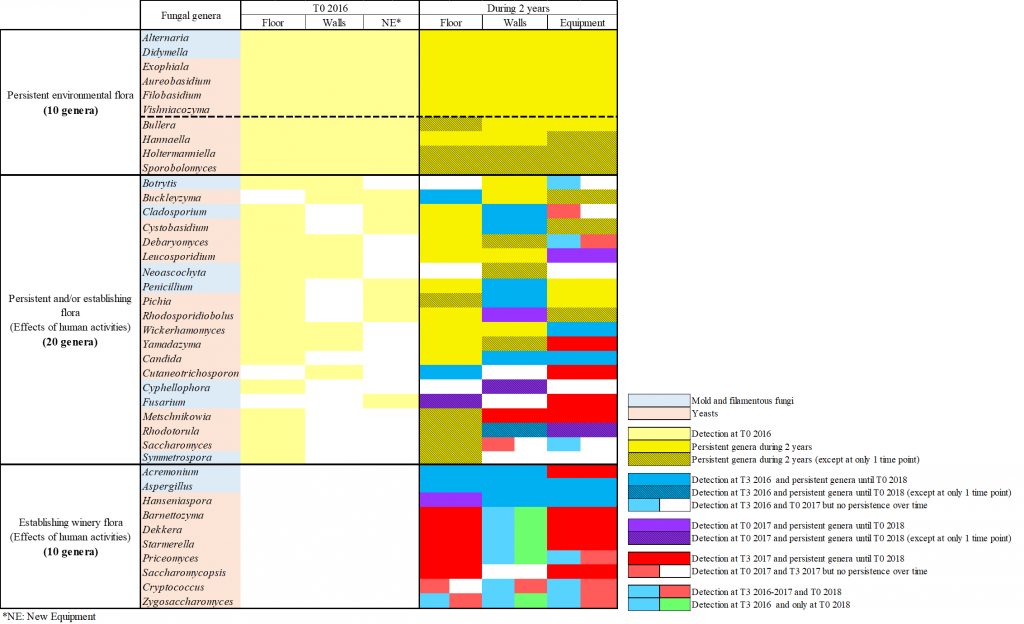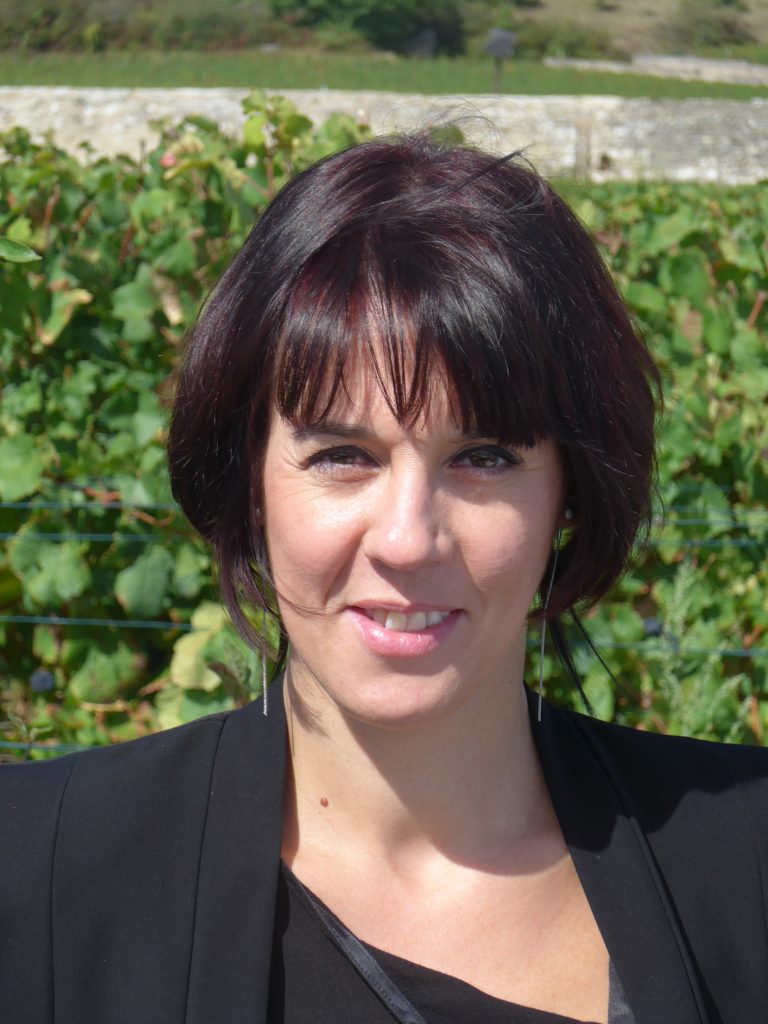By Sandrine Rousseaux
Over the years, extensive research has been conducted on microbial biodiversity during the winemaking process. Microorganisms including filamentous fungi, bacteria and yeasts have been identified throughout the whole process using conventional culture-dependent techniques or molecular methods resulting in the description of this process as a true microbial ecosystem. To understand the different roles of these microorganisms, especially yeasts, in wine fermentation and their impact on wine quality, in-depth knowledge of their population dynamics is needed. The development of recent technologies such as Next-Generation Sequencing (NGS) provided more complete understanding of the complexities of microbial communities. Moreover, these methods made it possible to study diversity in more varied ecosystems like Wine-Related Environments (WREs: floor, walls and equipment).
The various works carried out on this topic described the presence of the same genera, species and/or, in sometimes, the same strains in different WREs and during the winemaking process, suggesting the persistence of these microorganisms during several vintages and their transfer between different WREs or between WREs and must or wine. So, these studies highlighted: (i) the important role of WREs as an ecological niche for winery flora, and (ii) the implication of winery resident flora in the winemaking process.
However, all these works have been carried out in wineries in production. Very little information exists on the evolution of the microbial populations in a new winery. Yet, since the beginning of the 21st century, the number of new wineries has been increasing worldwide.
So, the study of the evolution of microbial populations on the WREs of a new winery is of high interest. In this direction, in a recent study we collected several samples from three different winery surfaces (floor, walls and equipment), for three consecutive vintages (2016, 2017 and 2018) and at separate time points [before grape harvest (T0) and 3 months after fermentation(T3)] and used NGS technologies to study the fungal biodiversity populations in the WREs of a new winery. We were able to study population microbial dynamics over time focusing on the contribution of fungal populations present on grapes and in must to WREs populations. We gained new insights on the capacities and mechanisms developed in the establishment or colonization of a fungal consortium in the winery environment.
Fungal status of the new winery before the arrival of the first harvest
The fungal diversity on the WREs of a new winery operating exclusively in spontaneous fermentation was studied to determine the fungal status of the winery before the arrival of the first harvest (T0 2016). Samples were collected from the floor, walls, new (NE) and used (UE) equipment. After Illumina sequencing, fungal OTUs were classified into 3 categories: (i) the mold and filamentous fungi genera, (ii) the yeast genera never described before in the winemaking process (named non-enological yeasts), and (iii) the yeast and yeast-like genera already described in the winemaking process (named wine-associated yeasts). Wine-associated yeasts include all the genera described in the literature in the vineyard, vine, grapes, must, wine and winery surfaces.
Mold and filamentous fungi dominated the fungal genera identified on all the surfaces before the first harvest, with 294 different genera. Yeast genera (non-enological and wine-associated) were identified before the arrival of any harvest in any of the WREs and a total of 35 different genera were found. Wine-associated yeasts were identified on all the studied surfaces of the new winery and dominated the yeast population detected. So, a total of 329 different fungal genera were identified before the first harvest (T0 2016) on all the WREs of a new minery, which have never been described before.
Establishment of a winery consortium
After 2 years, 172 fungal genera (132 mold and filamentous fungi and 40 yeasts) were identified and 17 fungal genera were newly detected (5 mold and filamentous fungi and 12 yeasts). By studying the evolution of these fungal populations during 2 complete vintages (T0 2016 to T0 2018), different evolutions over time were observed for 40 genera (mold, filamentous fungi and yeasts) (Fig. 1).

Figure 1: Resident and established fungal genera detected in the different WREs. Mold and filamentous fungi genera represented are >1% of relative abundance.
In first, the fungal consortium in a new winery consisted of persistent environmental flora that is not specific to the winery environment. These environmental flora included mold, filamentous fungi (e.g. Alternaria, Didymella) and yeasts (e.g. Aureobasidium, Filobasidium) (Fig. 1). Secondly, certain genera (e.g. Candida) were found before the arrival of the first harvest on one WREs, mainly on the winery floor, and persisted over time. Meanwhile, on the other WREs, the same genera were detected following the start of the harvest. Therefore, this finding suggests that these genera are well adapted to one specific environment of the winery and could be classified as persistent flora and/or establishing flora (Fig. 1). Finally, during 2 vintages, the environmental flora was enriched by other fungal genera (e.g. Acremonium, Hanseniaspora) (Fig. 1). These genera were considered as establishing winery flora and are less adapted to the winery environment.
This work provided new insights into the establishment of the fungal consortium in a new winery
Sourced from the research article “The establishment of a fungal consortium in a new winery” Abdo Hany, Catacchio Claudia Rita, Ventura Mario, D’Addabbo Pietro, Alexandre Hervé, Guilloux-Bénatier Michèle and Rousseaux Sandrine Scientific Reports volume 10, Article number: 7962 (2020) https://doi.org/10.1038/s41598-020-64819-2
Correspondence to : Sandrine.rousseaux@u-bourgogne.fr

Dr. Sandrine Rousseaux
Assistant professor in Viticulture and Microbiology, Vine pests at the Vine and Wine Institute (IUVV) of the University of Burgundy (uB) and responsible of a Master’s degree in Vine wine and Terroir.
She performs its research in the “Vin Aliment Microbiologie Stress” team at the Institut Universitaire de la Vigne et du Vin, Dijon. Her main thematic deals with the evolution of communities in different environments (soil, vine, must or wine but also in winery and cellar) using global approaches (independant culture methods) but also characterization and identification techniques at strain level. She study also different wine microorganisms (species of oenological interest or alteration).
http://www.umr-pam.fr/images/stories/pdf/Fiches_Individuelles/sandrine-rousseaux.pdf
https://www.researchgate.net/profile/Sandrine_Rousseaux
Grangeteau C, Roullier-Gall C, Rousseaux S, Gougeon RD, Schmitt-Kopplin P, Alexandre H, Guilloux-Benatier M (2017). Wine microbiology is driven by vineyard and winery anthropogenic factors. Microbial Biotechnology 10.1111/1751-7915.12428. Microb Biotechnol. 10: 354-370.
Grangeteau C, David V, Alexandre H, Guilloux-Benatier M Rousseaux S (2017). The sensitivity of yeasts and yeasts-like fungi to copper and sulfur could explain lower yeast biodiversity in organic vineyards? FEMS Yeast Research, 17 (8)
Paterson RRM, Venancio A, Lima N, Guilloux-Benatier M, Rousseaux S (2018) Predominant mycotoxins, mycotoxigenic fungi and climate change related to wine. A review Food Research International 103: 478-491 https://doi.org/10.1016/j.foodres.2017.09.080
Abdo H, Catacchio CR, Ventura M, D’Addabbo P, Laurent J, David-Vaizant V, Alexandre H, Guilloux-Bénatier M, Rousseaux S (2020) Colonization of wild Saccharomyces cerevisiae strains in a new winery. Beverages. Beverages 2020, 6(1), 9; doi:10.3390/beverages6010009





